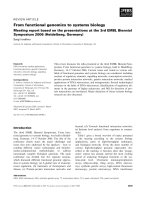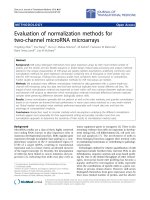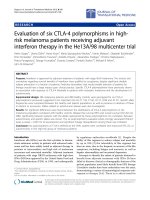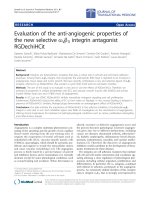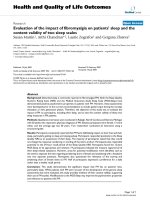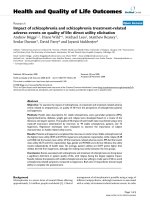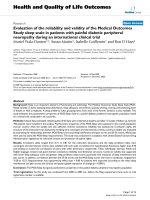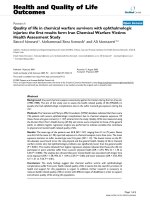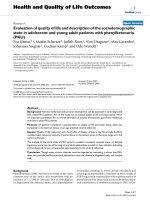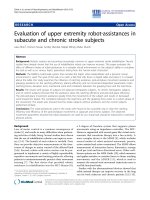báo cáo hóa học: " Evaluation of adaptation to visually induced motion sickness based on the maximum cross-correlation between pulse transmission time and heart rate" docx
Bạn đang xem bản rút gọn của tài liệu. Xem và tải ngay bản đầy đủ của tài liệu tại đây (364.84 KB, 6 trang )
BioMed Central
Page 1 of 6
(page number not for citation purposes)
Journal of NeuroEngineering and
Rehabilitation
Open Access
Research
Evaluation of adaptation to visually induced motion sickness based
on the maximum cross-correlation between pulse transmission
time and heart rate
Norihiro Sugita*
1
, Makoto Yoshizawa
2
, Makoto Abe
1
, Akira Tanaka
3
,
Takashi Watanabe
2
, Shigeru Chiba
4
, Tomoyuki Yambe
5
and Shin-ichi Nitta
5
Address:
1
Graduate School of Engineering, Tohoku University, Aoba 6-6-05, Aramaki, Aoba-ku, Sendai, 980-8579, Japan,
2
Information Synergy
Center, Tohoku University, Aoba 6-6-05, Aramaki, Aoba-ku, Sendai, 980-8579, Japan,
3
Faculty of Symbiotic Systems Science, Fukushima
University, Kanayagawa 1, Fukushima, 960-1296, Japan,
4
Sharp Corporation, 1-9-2 Nakase, Mihama-ku, Chiba, 261-8520, Japan and
5
Institute
of Development, Aging and Cancer, Tohoku University, 4-1 Seiryo-machi, Aoba-ku, Sendai, 980-8575, Japan
Email: Norihiro Sugita* - ; Makoto Yoshizawa - ;
Makoto Abe - ; Akira Tanaka - ;
Takashi Watanabe - ; Shigeru Chiba - ;
Tomoyuki Yambe - ; Shin-ichi Nitta -
* Corresponding author
Abstract
Background: Computer graphics and virtual reality techniques are useful to develop automatic
and effective rehabilitation systems. However, a kind of virtual environment including unstable
visual images presented to wide field screen or a head mounted display tends to induce motion
sickness. The motion sickness induced in using a rehabilitation system not only inhibits effective
training but also may harm patients' health. There are few studies that have objectively evaluated
the effects of the repetitive exposures to these stimuli on humans. The purpose of this study is to
investigate the adaptation to visually induced motion sickness by physiological data.
Methods: An experiment was carried out in which the same video image was presented to human
subjects three times. We evaluated changes of the intensity of motion sickness they suffered from
by a subjective score and the physiological index
ρ
max
, which is defined as the maximum cross-
correlation coefficient between heart rate and pulse wave transmission time and is considered to
reflect the autonomic nervous activity.
Results: The results showed adaptation to visually-induced motion sickness by the repetitive
presentation of the same image both in the subjective and the objective indices. However, there
were some subjects whose intensity of sickness increased. Thus, it was possible to know the part
in the video image which related to motion sickness by analyzing changes in
ρ
max
with time.
Conclusion: The physiological index,
ρ
max
, will be a good index for assessing the adaptation
process to visually induced motion sickness and may be useful in checking the safety of
rehabilitation systems with new image technologies.
Published: 28 September 2007
Journal of NeuroEngineering and Rehabilitation 2007, 4:35 doi:10.1186/1743-0003-4-35
Received: 5 June 2006
Accepted: 28 September 2007
This article is available from: />© 2007 Sugita et al; licensee BioMed Central Ltd.
This is an Open Access article distributed under the terms of the Creative Commons Attribution License ( />),
which permits unrestricted use, distribution, and reproduction in any medium, provided the original work is properly cited.
Journal of NeuroEngineering and Rehabilitation 2007, 4:35 />Page 2 of 6
(page number not for citation purposes)
Background
In recent years, medical services including rehabilitation
programs are changing substantially as results of rapid
aging of the population and medical cost inflation. In
Japan in 2006, a new law regarding the national health
was passed and it fixes a 6 months limit to the coverage for
rehabilitation programs. For this reason, more effective
and efficient rehabilitation methods are needed to finish
a rehabilitation program in a short period of time. In
addition, a shortage of manpower for rehabilitation pro-
grams grows into a serious problem and therefore it is nec-
essary to automate rehabilitation systems.
In such situations, computer graphics and virtual reality
(VR) techniques are useful to develop automatic and
effective rehabilitation systems. A system using these tech-
niques is not only safe to use but also attractive for
patients, thus some new methods for physical and mental
rehabilitation have been proposed [1-5].
However, there are concerns about possible adverse effects
of watching novel visual images and experience of VR,
such as photosensitive seizures [6,7], visually induced
motion sickness (VIMS) [8-11] and eye strain. In particu-
lar, when a patient watches an image changed based on
real-time information of his head-position, which is
sometimes used in VR system, there is a possibility that he
watches unexpected images, such as upside-down or rotat-
ing, and then he feels VIMS. Since almost all users of the
rehabilitation system are aged and/or physically weak,
mental or physical stress on them caused by VIMS is con-
sidered to be greater than on healthy users.
To prevent these problems, we should establish methods
to evaluate the effects of visual stimulation on humans
and check a new rehabilitation system prior to use. For
this purpose, it would be effective to estimate the auto-
nomic nervous activity by analyzing physiological data
such as heart rate and blood pressure [12-14]. A previous
study [14] showed that the physiological index,
ρ
max
,
defined as the maximum cross-correlation coefficient
between heart rate and blood pressure and whose fre-
quency components are limited to the Mayer wave-related
band, is capable of assessing VIMS.
On the other hand, an important feature of motion sick-
ness is the adaptation process. Adaptation occurs with
repetitive exposure to the motion that causes the motion
sickness [8,9]. The repetitive exposure usually improves
motion sickness. This means that the response of
ρ
max
to
the repetitive exposure to the same visual stimulation will
be reduced. Most of aged people are inexperienced in
watching artificial visual images used in new types of reha-
bilitation systems and they may feel VIMS at the first time.
However, if the symptoms of VIMS improve quickly as the
day goes on, patients will be able to use the system.
The purpose of this study is to investigate the adaptation
to VIMS by using both subjective and objective indices.
We carried out an experiment in which the same video
image was presented to subjects three times and analyzed
the changes in a subjective score for VIMS and their auto-
nomic nervous activity which was evaluated by continu-
ous estimation of
ρ
max
.
Methods
Experiments
Figure 1 shows a schematic illustration of the experiment.
A total of 21 healthy subjects participated in the study.
Due to the number of devices available for measuring
ECG and plethysmogram, a maximum of 11 subjects
could watch the same video image simultaneously in any
given trial of the experiment. Therefore, the experiment
was conducted in two groups. The first had ten subjects (9
males and 1 females; 21.0 ± 2.0 years), and the second 11
(10 males and 1 females; 20.3 ± 1.8 years). They watched
the same video image, projected by a LCD projector (res-
olution: 1024 × 768, brightness: 3250 ANSI lumens),
once a day, for three consecutive days. Each subject
watched at the same position from the screen and at the
same time of each day. The experimental protocol was
approved by the University's Internal Review Board and
informed consent was obtained from all subjects before
the experiment.
The video film presented to the subjects was clipped from
a movie made in the U.S.A. in 1999. The movie is notori-
ous for inducing VIMS because it was taken by a handheld
camera swayed intentionally to enhance the sensation of
Schematic illustration of the simultaneous experiment with multiple subjects watching the same video imageFigure 1
Schematic illustration of the simultaneous experiment with
multiple subjects watching the same video image.
Journal of NeuroEngineering and Rehabilitation 2007, 4:35 />Page 3 of 6
(page number not for citation purposes)
reality. To prevent emotional effects, violent scenes
included in the film were excluded. The protocol of a
given trial was as follows: 1) subjects watched a still pic-
ture of a landscape for 5 min as a control; 2) they watched
the 15 min video image described above; 3) the same still
picture shown in step 1 was watched again for 5 min. After
the trial, each subject filled out the Simulator Sickness
Questionnaire (SSQ) [15]. The total score (TS) on the SSQ
is assumed to represent the subjective intensity of VIMS;
the higher the TS, the more strongly a subject felt motion
sickness. In each trial, ECG and finger photo-plethysmo-
gram signals were measured and recorded with a hand-
made Mayer-wave analyzer [16]. The resolution of A/D
converter and the sampling rate are 12 bit and 1 kHz,
respectively.
Analysis
Heart rate (HR) was calculated from the reciprocal of the
inter-R-wave interval of the ECG signal. Arterial pulse
wave transmission time (PTT) was defined as the time
interval from the peak of the ECG, R-wave, to the point at
which the plethysmogram signal begins to rise. The value
of PTT is related to blood pressure, as it is dependent on
vascular compliance, which is affected by blood pressure
[17]. Moreover, instantaneous measurements of PTT are
much easier to obtain than measurements of blood pres-
sure. Thus, PTT was used instead of blood pressure to cal-
culate
ρ
max
(described in detail below) to evaluate changes
in autonomic nervous activity [18].
HR and PTT were interpolated by cubic spline functions to
be continuous-time functions, and were re-sampled every
∆
t = 0.5 s. Each data point was then filtered through a
band-pass filter with a bandwidth between 0.08 Hz and
0.1 Hz to extract the Mayer wave component.
To compute the cross-correlation coefficient between
these two values, let us k denote the discrete time based on
k
∆
t. For a simple expression, x(k) = PTT(k) and y(k) =
HR(k). At each second, the cross-correlation function,
ϕ
xy
(
τ
), at lag time
τ
from x(k) to y(k) was calculated time-
discretely on the basis of 2 min data segments weighted
with the Hamming window from -1 min to 1 min. The
cross-correlation coefficient,
ρ
xy
(
τ
), was obtained by nor-
malizing
ϕ
xy
(
τ
) with root mean square values of x(k) and
y(k) as follows:
where
ϕ
xx
(
τ
) and
ϕ
yy
(
τ
) are auto-correlation functions of
x(k) and y(k), respectively. Furthermore, the maximum
cross-correlation coefficient is defined as physiological
index:
ρ
max
= max
ρ
xy
(
τ
)(2)
In practice, we obtained
ρ
max
in a range of
τ
from 0 s to 7 s.
Results
Two subjects out of 21 complained of VIMS so strongly
that they could not complete the trials. Another 5 subjects'
data contained artifact and could not be used. Therefore,
out of 21 subjects, data from only 14 were available for
analysis.
Figure 2 shows individual changes in these subjects' TS on
the SSQ from the first day (Day 1) to the third day (Day
3). Based on increase or decrease in the change of TS from
Day 1 to Day 3, subjects could be divided into two groups:
a group of decreased TS (TS-down; n = 8) and a group of
increased TS (TS-up; n = 5). A subject belonged to neither
group because his TS did not change at all between two
days. There was no significant difference in TS between
two groups on Day1, but on Day3, the difference between
them was significant (t-test, p < 0.01).
Figure 3 shows the change in
ρ
max
with time of three typi-
cal subjects. Subject-1, shown in Fig. 3a, belonged to the
TS-down group. He reported feeling strong VIMS sensa-
tions on the first day, but the intensity of his sickness
decreased at the third day. His
ρ
max
decreased at the same
time (around 720 s) on both days but decreased at around
900 s only on the first day. On the other hand,
ρ
max
of Sub-
ject-2 (Fig. 3b), who belonged to the TS-up group,
decreased considerably in the latter part of the video
(720–900 s) and decreased again after watching on both
days. Subject-3 (Fig. 3c) did not report feeling much VIMS
on any day and there were no apparent changes in his
ρ
max
on both days.
ρτ
ϕτ
ϕϕ
xy
xy
xx yy
()
()
() ()
=
⋅00
(1)
Change, from Day 1 to Day 3, in SSQ total score (TS) of 14 subjectsFigure 2
Change, from Day 1 to Day 3, in SSQ total score (TS) of 14
subjects.
Journal of NeuroEngineering and Rehabilitation 2007, 4:35 />Page 4 of 6
(page number not for citation purposes)
To investigate the relationship between the exposure time
of visual stimulation and the biological effects of it, we
divided the duration of watching the video in quarters,
Part-1 (300–525 s), Part-2 (525–750 s), Part-3 (750–975
s) and Part-4 (975–1200 s), and we averaged the
ρ
max
over
each interval with respect to each subject. Figure 4 shows
changes in
ρ
max
of individual subjects from Day 1 to Day
3. Each value represents
ρ
max
at Part-3. As shown in this
figure, the
ρ
max
increased for 5 of 8 subjects in TS-down
group and for 2 of 5 subjects in TS-up group.
Figure 5 shows the course of the mean
ρ
max
changes of TS-
down and TS-up groups on Day1 and Day3. On Day1, the
ρ
max
changes of two groups were similar to each other.
However, on Day3, the
ρ
max
of TS-up group markedly
decreased while watching the video and there was signifi-
cant difference between the two groups both at Part-2 and
Part-3 (t-test, p < 0.05). In addition, between Day1 and
Day3, there was a delay in the time when the
ρ
max
of TS-
down group decreased, i.e. the mean value of
ρ
max
of TS-
down group decreased at Part-3 on Day1 while decreased
at Part-4 on Day3.
Discussion
As shown in Fig. 2, the subjective score for VIMS (i.e. TS)
decreased for 8 of the 14 subjects through repetition of
watching the same video image. Especially for top 7 sub-
jects with high TS on the first day, TS of 5 subjects
decreased. This change is considered to be adaptation,
namely habituation, to the video image and similar
results were reported in previous studies [8,9].
The
ρ
max
of Subject-2 whose TS were high both on Day1
and Day3 decreased at the same point (720–900 s; Fig.
the course of the mean
ρ
max
changes of TS-down and TS-up group on Day1 and Day3Figure 5
the course of the mean
ρ
max
changes of TS-down and TS-up
group on Day1 and Day3. *p < 0.05.
Changes in
ρ
max
with time (left column) and TS (right column) of three subjects on the first and the third daysFigure 3
Changes in
ρ
max
with time (left column) and TS (right column)
of three subjects on the first and the third days. a) A subject
whose TS decreased (TS-down group), b) one whose TS
increased (TS-up group) and c) one whose TS changed little.
Change, from Day1 to Day3, in
ρ
max
of individual subjects watching the video at Part-3 (from 750 to 975 s)Figure 4
Change, from Day1 to Day3, in
ρ
max
of individual subjects
watching the video at Part-3 (from 750 to 975 s).
Journal of NeuroEngineering and Rehabilitation 2007, 4:35 />Page 5 of 6
(page number not for citation purposes)
3b) on both days while that of Subject-3 whose TS were
low did not change much (Fig. 3c). These results suggest
that the autonomic nervous activity of the subject who
actually suffered from VIMS was disturbed by watching
the swaying video image; this action affected his barore-
flex system, which resulted in a decreased
ρ
max
. The
decrease in
ρ
max
of Subject-2 at this part of the video agrees
with results of previous studies, that it takes about 5 to 10
minutes for the subject to feel the symptoms of VIMS
[10,11].
Moreover, the
ρ
max
of Subject-1 decreased considerably at
around 900 s on Day 1 but not on Day 3. This result may
correspond to the decrease in his TS (i.e. the decrease in
the intensity of VIMS) on Day 3. It is suggested that this
phenomenon represents an adaptation to VIMS derived
from the repetitive exposure to the same swaying video
image.
On the other hand, TS of the 5 subjects on Day 3 were
higher than on Day 1 such as Subject-2 who belonged to
TS-up group. The changes in
ρ
max
of these subjects almost
correspond to the changes in their TS, i.e.
ρ
max
decreased
considerably for 3 of the 5 subjects. Thus it is suggested
that VIMS worsened by repetitive exposure to the swaying
video image for some subjects. As shown in Fig. 5, the
mean value of
ρ
max
of TS-up group decreased from the ear-
lier part of the video on Day 3 than on Day 1 and there
was significant difference in the
ρ
max
between TS-down
and TS-up groups at the middle parts of the video, Part-2
and Part-3. This result indicates that the repetition of
watching made some subjects more sensitive to the sway-
ing video and their autonomic nervous system or related
physiological mechanism changed easily.
In the result shown in Fig. 4, there were 3 subjects whose
TS decreased but their
ρ
max
increased over the three days.
However, in these subjects,
ρ
max
was higher than 0.9 (the
maximum value of
ρ
max
is 1.0) both on Day1 and Day3.
Therefore, this result is considered to be caused not by
non-adaptation to the swaying video but by no room for
ρ
max
increasing.
Furthermore, on the first day of the experiment, the sub-
jects might feel nervous or anxiety about the experiment
itself, which they had never experienced [19]. For this rea-
son, we must also consider possibility that the low
ρ
max
was caused by these psychological effects. To test this
hypothesis, we should carry out experiments in which the
subjects watch just the landscape for the entire 25 min on
three days, or we should adjust the subjects to the appara-
tus before experiments.
In terms of rehabilitation, VIMS induced in using a reha-
bilitation system not only inhibits effective training but
also may harm patients' health. However, by using the
evaluation indices such as TS and
ρ
max
, we can check
whether a rehabilitation system is safe or not and explore
the cause of VIMS. In addition, these indices may be use-
ful in the evaluation of the efficacy of vestibular rehabili-
tation. Some studies have proposed rehabilitation for the
treatment of vestibular disorders with the use of the VR
technique [20,21]. Patients with vestibular disorders have
symptoms of vertigo, vomiting and disequilibrium. If
physiological indices such as
ρ
max
reflect the intensity of
these symptoms, it is possible to evaluate the recovery
process of vestibular disorders during a rehabilitation pro-
gram.
Conclusion
In this study, a subjective index TS, the self-rating score of
motion sickness, and a physiological index
ρ
max
, reflecting
autonomic nervous activity, were employed to assess
adaptation to VIMS.
In the experiment, the same VIMS-inducing video image
was shown to all subjects once each on three consecutive
days. The analyses of TS and
ρ
max
for 14 subjects revealed:
1) TS decreased from the first day to the third day for more
than half of all the subjects (TS-down group). 2) There
were some subjects whose intensity of VIMS increased as
the number of the exposures increased (TS-up group). 3)
ρ
max
of the subjects feeling VIMS decreased at the same
point of time on both days. 4) After repetitions of watch-
ing the same video image, the
ρ
max
of TS-down group
increased at the middle part of the video while that of TS-
up group decreased.
In the future, we should check whether the adaptation
occurs with more repetitions of the visual stimuli because
there is a possibility that the number of repetitions in this
experiment was too small for adaptation, and should
investigate adaptation in the case of watching other video
images and VR experience. Moreover, individual differ-
ences need to be investigated in more depth. It was
reported that not only differences in gender and age
[22,23] but also physical and sporting activities [24] affect
the susceptibility to motion sickness. These factors should
be associated with the differences in
ρ
max
shown in the
present study between the TS-down and TS-up groups.
Competing interests
The author(s) declare that they have no competing inter-
ests.
Authors' contributions
All authors read and approved the final manuscript. NS
carried out the experiment and drafted the manuscript.
MY participated in the design of the study and helped to
draft the manuscript. MA carried out the experiment and
Publish with BioMed Central and every
scientist can read your work free of charge
"BioMed Central will be the most significant development for
disseminating the results of biomedical research in our lifetime."
Sir Paul Nurse, Cancer Research UK
Your research papers will be:
available free of charge to the entire biomedical community
peer reviewed and published immediately upon acceptance
cited in PubMed and archived on PubMed Central
yours — you keep the copyright
Submit your manuscript here:
/>BioMedcentral
Journal of NeuroEngineering and Rehabilitation 2007, 4:35 />Page 6 of 6
(page number not for citation purposes)
performed the analysis of data. AT participated in the
design of the study. TW, SC, TY and SN helped to draft the
manuscript.
Acknowledgements
The authors would like to thank all participants. Written consent for pub-
lication was obtained from the participant.
References
1. Rothbaum BO, Hodges LF, Kooper R, Opdyke D, Williford JS, North
M: Effectiveness of computer-generated (virtual reality)
graded exposure in the treatment of acrophobia. Am J Psychi-
atry 1995, 152(4):626-628.
2. Girone M, Burdea G, Bouzit M, Popescu V, Deutsch JE: Orthopedic
rehabilitation using the "Rutgers ankle" interface. Stud Health
Technol Inform 2000, 70:89-95.
3. Merians AS, Jack D, Boian R, Tremaine M, Burdea GC, Adamovich SV,
Recce M, Poizner H: Virtual reality-augmented rehabilitation
for patients following stroke. Phys Ther 2002, 82(9):898-915.
4. Sveistrup H, McComas J, Thornton M, Marshall S, Finestone H,
McCormick A, Babulic K, Mayhew A: Experimental studies of vir-
tual reality-delivered compared to conventional exercise
programs for rehabilitation. Cyberpsychol Behav 2003,
6(3):245-249.
5. Baheux K, Yoshizawa M, Tanaka A, Seki K, Handa Y: Diagnosis and
rehabilitation of hemispatial neglect patients with virtual
reality technology. Technol Health Care 2005, 13(4):245-260.
6. Quirk JA, Fish DR, Smith SJM, Sander JWAS, Shorvon SD, Allen PJ:
Incidence of photosensitive epilepsy: a prospective national
study. Electroenceph Clin Neurophysiol 1995, 95(4):260-267.
7. Harding GFA: TV can be bad for your health. Nature Med 1998,
4:265-267.
8. Regan EC: Some evidence of adaptation to immersion in vir-
tual reality. Displays 1995, 16(3):135-139.
9. Hill KJ, Howarth PA: Habituation to the side effects of immer-
sion in a virtual environment. Displays 2000, 21(1):25-31.
10. Lo WT, So RH: Cybersickness in the presence of scene rota-
tional movements along different axes. Appl Ergon 2001,
32(1):1-14.
11. Ohmi M, Ujike H: Self-orientation and motion sickness which
is induced by visual information. BME 2004, 18(1):32-39. (in Jap-
anese)
12. Cowings PS, Naifeh KH, Toscane WB: The stability of individual
patterns of autonomic responses to motion sickness stimu-
lation. Aviat Space Environ Med 1990, 61(5):399-405.
13. Holmes SR, Griffin MJ: Correlation between heart rate and the
severity of motion sickness caused by optokinetic stimula-
tion. J Psychophysiol 2001, 15(1):35-42.
14. Sugita N, Yoshizawa M, Tanaka A, Abe K, Yambe T, Nitta S: Evalua-
tion of effect of visual stimulation on humans based on max-
imum cross-correlation coefficient between blood pressure
and heart rate. J Human Interface Japan 2002, 4(4):39-46. (in Japa-
nese)
15. Kennedy RS, Lane NE: Simulator sickness questionnaire: An
enhanced method for quantifying simulator sickness. Int J
Aviat Psychol 1993, 3(3):203-220.
16. Sugita N, Yoshizawa M, Tanaka A, Abe K, Chiba S, Yambe T, Nitta S:
Evaluation of the effect of visual stimulation on humans by
simultaneous experiment with multiple subjects. Proc 27th Int
Conf IEEE Eng Med Biol: 1–4 September 2005; Shanghai 2005. CD-ROM
17. Gribbin B, Steptoe A, Sleight P: Pulse wave velocity as a measure
of blood pressure change. Psychophysiology 1976, 13(1):86-90.
18. Yoshizawa M, Sugita N, Tanaka A, Masuda T, Abe K, Yambe T, Nitta
S: Quantification of emotional reaction based on cross-corre-
lation between pulse wave transmission time and heart rate
in the Mayer wave-band. J Japan Circ Cont in Med 2004,
25(1):41-49. (in Japanese)
19. Sugita N, Yoshizawa M, Tanaka A, Abe K, Yambe T, Nitta S, Chiba S:
Biphasic Response of Autonomic Nervous System to Visu-
ally-Induced Motion Sickness. Trans Virtual Reality Japan 2004,
9(4):369-375. (in Japanese)
20. Kramer PD, Roberts DC, Shelhamer M, Zee DS: A versatile stere-
oscopic visual display system for vestibular and oculomotor
research. J Vestib Res 1998, 8(5):363-379.
21. Sparto JP, Whitney LS, Hodges FL, Furman MJ, Redfern SM: Simula-
tor sickness when performing gaze shifts within a wide field
of view optic flow environment: preliminary evidence for
using virtual reality in vestibular rehabilitation. J Neuroeng and
Rehabi 2004, 1(1):1-10.
22. Cooper C, Dunbar N, Mira M: Sex and seasickness on the Coral
Sea. Lancet 1997, 350:892.
23. Dobie T, McBride D, Dobie T Jr, May J: The effects of age and sex
on susceptibility to motion sickness. Aviat Space Environ Med
2001, 72:13-20.
24. Caillet G, Bosser G, Gauchard GC, Chau N, Benamghar L, Perrin PP:
Effect of sporting activity practice on susceptibility to
motion sickness. Brain Res Bull 2006, 69(3):288-293.
